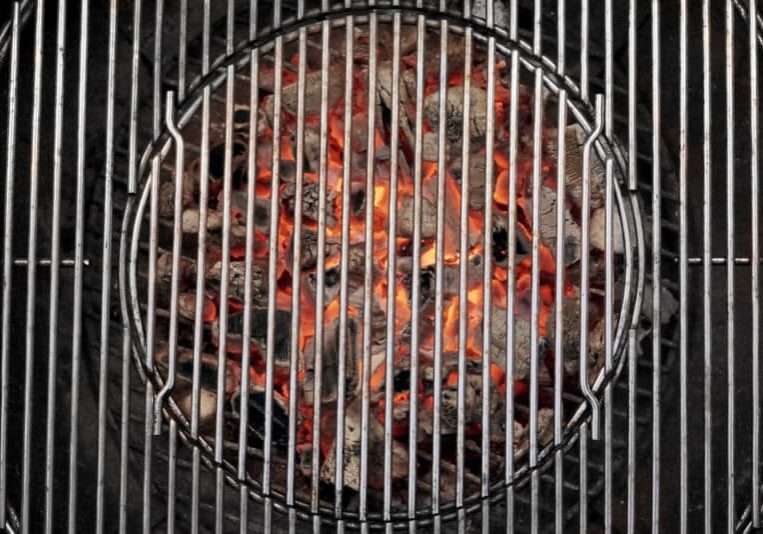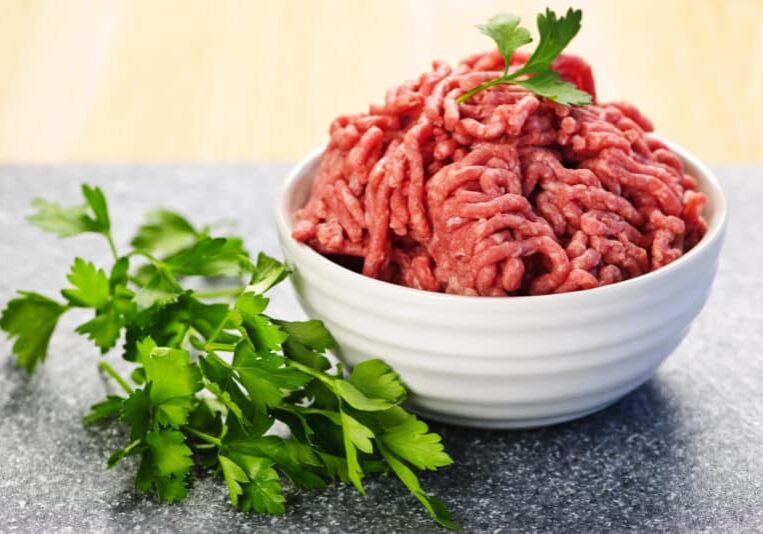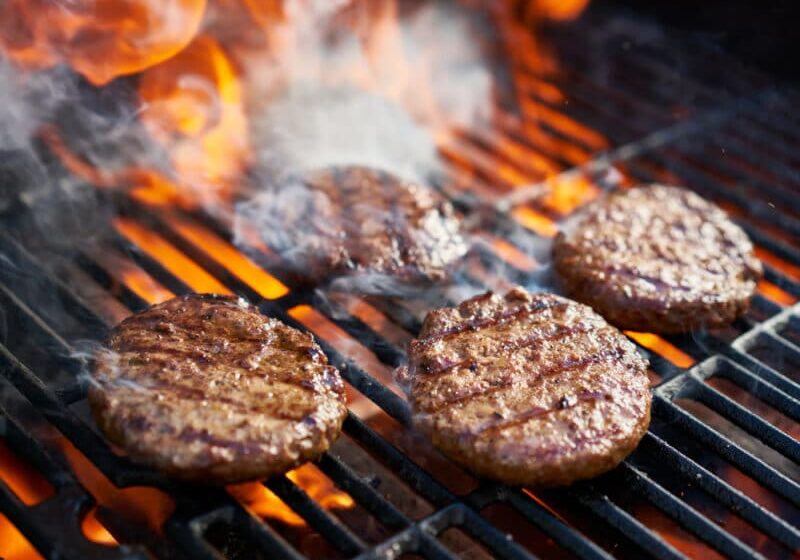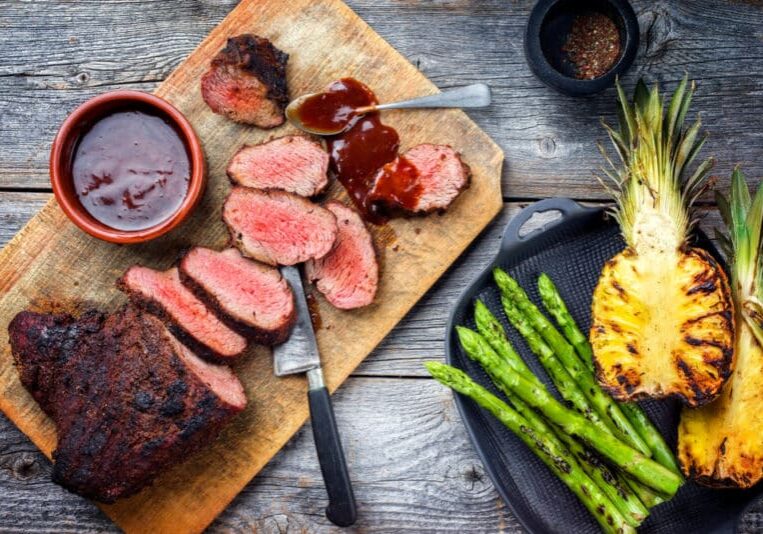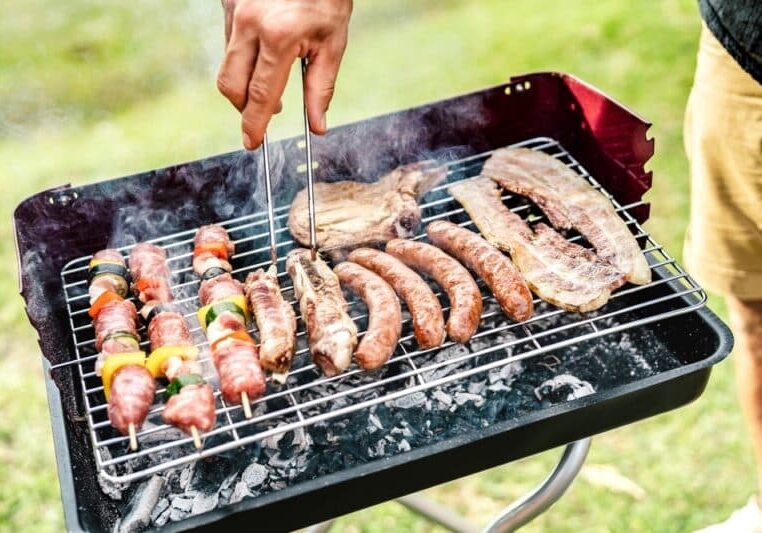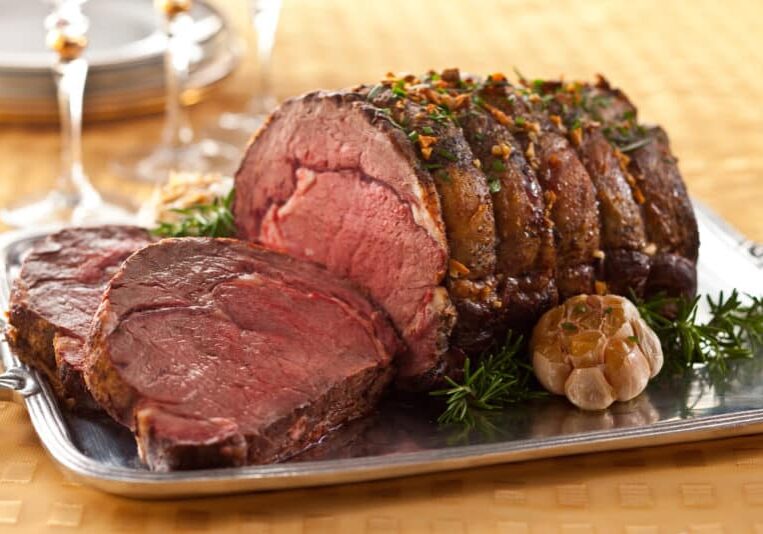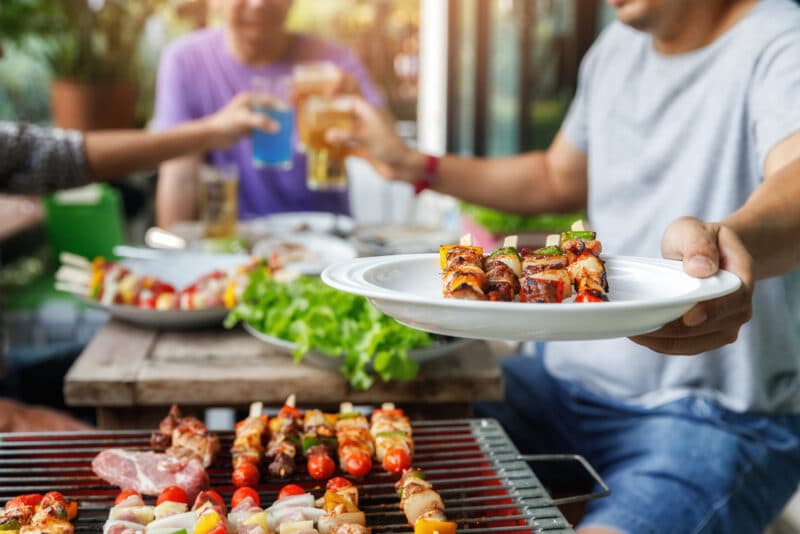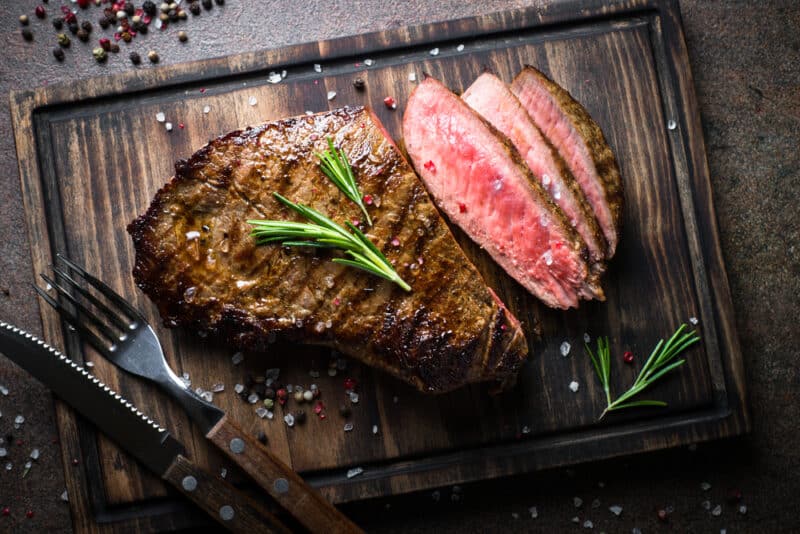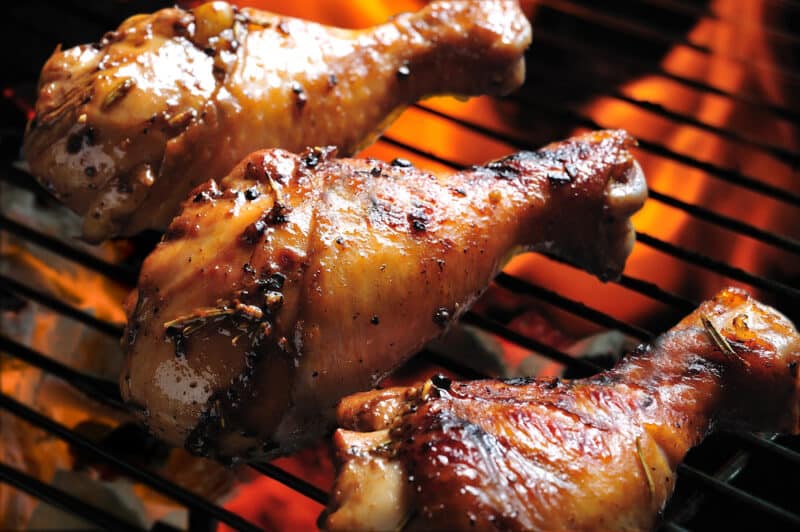How to Smoke Ribs on a Charcoal Grill: A Step-by-Step Guide
TheGrillingMaster.com is reader-supported. If you buy something using the links on our site, we might earn an affiliate commission at no added cost to you. This helps us pay our staff to keep making awesome content for you!
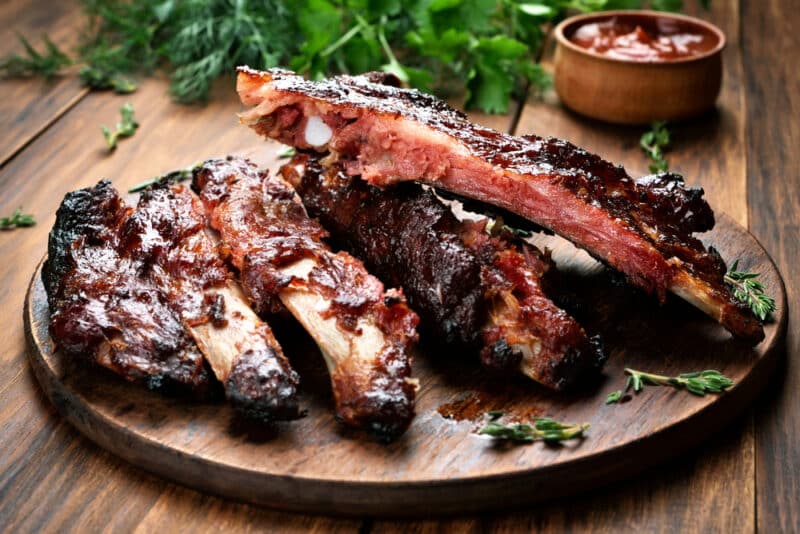
Having trouble nailing that deep, smoky flavor on your ribs when using a charcoal grill? You’re not alone. In my own quest for barbeque perfection, I’ve learned that about 25% of at-home grillers feel they just can’t replicate that authentic smokehouse taste.
Fear not—my guide is all about making it simple to cook up mouthwateringly smoky ribs without needing any specialized gear. So let’s get that grill going and jump into the process together!
Key Takeaways
- Choose the right type of ribs for smoking: either spare ribs or baby back ribs, each offering different flavors and textures.
- Prepare your charcoal grill for indirect heat and use a two – zone method to control temperature for even cooking.
- Apply a dry rub to the trimmed and membrane – free ribs, allowing them to absorb flavors before grilling.
- Maintain a steady grill temperature (225 – 250°F) while smoking; add soaked wood chips for smoke flavor and check meat with a thermometer for doneness.
- After smoking, wrap ribs in foil and let them rest inside a cooler wrapped in towels to ensure they remain tender and juicy.
Types of Ribs to Use for Smoking
When it comes to smoking ribs, there are two main types to consider: spare ribs and baby back ribs. Each type has its own unique flavor and texture, so it’s important to choose the right one for your smoking adventure.
In this section, we’ll discuss the differences between these two types of ribs and how to prepare them for smoking on a charcoal grill.
Spare Ribs
Spare ribs are a fantastic choice for smoking on your charcoal grill. These hearty cuts come from the belly side of the pig’s rib cage, larger and meatier than baby back ribs. I make sure to select ones with a good amount of marbling, because that fat melts during the smoking process, infusing the meat with flavor and keeping it moist.
Before they hit the grill, I trim any excess fat and remove the membrane on the underside to ensure my dry rub penetrates deep into every nook.
As I prepare my charcoal grill for those spare ribs, controlling heat is key. I arrange coals for indirect cooking and regulate airflow using grill vents—this way, temperatures stay within that sweet spot ideal for breaking down tough fibers without overcooking.
Each rack goes on over indirect heat; patience here is essential as they absorb that delicious smoky aroma from wood chips smoldering among the coals. Spare ribs take time to reach perfect tenderness but believe me; it’s worth every minute!
Baby Back Ribs
Baby back ribs are a popular choice for smoking on a charcoal grill due to their tender meat and delicious flavor. To prepare baby back ribs for smoking, I start by removing the membrane from the bone side of the ribs to ensure that the seasonings penetrate evenly.
Then, I apply a dry rub generously over the entire surface of the ribs, making sure to massage it in for maximum flavor. When it’s time to smoke, I place the seasoned baby back ribs on the grill using indirect heat and add wood chips to create a smoky flavor infusion.
Throughout the smoking process, maintaining a steady temperature is crucial for achieving perfectly tender and flavorful baby back ribs.
After allowing them to smoke until they reach desired tenderness, I wrap the baby back ribs in foil with some liquid and let them rest before serving. This final step helps lock in moisture and enhances their natural juiciness.
Preparation and Tools
For the preparation, start by trimming the ribs and removing the membrane to ensure maximum flavor absorption. Apply a dry rub of your choice and prepare your charcoal grill for indirect heat cooking.
Trimming the Ribs
To trim the ribs, use a sharp knife to remove the excess fat from both sides of the rack. Next, remove the membrane on the bone side by sliding a butter knife under it and then grabbing it with a paper towel to pull it off.
Finally, trim any loose or hanging bits of meat for even cooking.
After trimming, pat dry with paper towels before applying your dry rub. This step ensures that the spices adhere well to the meat for maximum flavor during smoking.
Applying a Dry Rub
After trimming the ribs to remove excess fat and silver skin, it’s time to apply the dry rub. First, I gently pat the ribs dry with paper towels to help the rub adhere better. Then, I generously sprinkle and massage the dry rub mixture onto both sides of the ribs until they are evenly coated.
This step is crucial for imparting flavor and creating a delicious crust on the smoked ribs.
To ensure that every bite is bursting with savory goodness, I make sure to get an even coating of the dry rub on all surfaces of the meat. After applying the dry rub, I let the ribs sit for at least 30 minutes or up to 24 hours in the refrigerator.
Preparing the Charcoal Grill
Now, let’s talk about preparing the charcoal grill. I start by arranging the charcoal in a two-zone setup to create direct and indirect heat zones. Once the coals are hot, I place wood chunks on top for added flavor.
After assembling the grill, I ensure that the vents are open to promote airflow and maintain a consistent temperature throughout the smoking process. Then, using long-handled tongs, I clean off any remaining residue from previous cooks before placing the ribs on the cooking grate directly over the indirect heat zone.
Once everything is set up properly, it’s time to monitor and adjust as needed while maintaining an even temperature of around 225-250°F (107-121°C) for several hours until our ribs are perfectly smoked and ready to be enjoyed.
Smoking the Ribs
After preparing the charcoal grill and applying the dry rub, it’s time to start smoking the ribs. This involves maintaining a steady temperature in the grill, adding wood chips for smoke, and monitoring the ribs throughout the smoking process.
Maintaining a Steady Temperature
To maintain a steady temperature while smoking ribs on a charcoal grill, I adjust the bottom vents to regulate airflow. This helps me control the heat inside the grill. By opening or closing the vents slightly, I can increase or decrease the temperature as needed.
I also keep an eye on the built-in thermometer and make small adjustments to the vents whenever there are fluctuations in temperature. This ensures that the ribs cook evenly and absorb just the right amount of smoky flavor without getting overcooked.
Adding Wood Chips for Smoke
I add wood chips for smoke to enhance the flavor of the ribs. Soaking the wood chips for about 30 minutes helps them smolder and produce a steady stream of flavorful smoke. Placing the soaked wood chips directly on the hot coals or in a smoker box infuses the meat with a rich, smoky essence that complements the dry rub and slow cooking process.
The smoky aroma fills the air as I carefully monitor and adjust the smoke levels to achieve just the right balance of flavor. Throughout this process, I maintain an optimal smoking temperature by adjusting airflow and adding more charcoal as needed.
This results in perfectly smoked ribs with delectable flavor that will leave everyone craving for more.
Monitoring the Ribs
Throughout the smoking process, I check the grill temperature every 30 minutes using a digital thermometer. This helps me maintain a steady cooking environment for the ribs and ensures that they cook evenly and thoroughly.
I also keep an eye on the color of the smoke coming out of the grill, making sure it stays a light blue to prevent any acrid flavors from developing in the meat. Once every hour, I rotate the ribs to ensure they cook uniformly on all sides.
During this time, I occasionally spritz apple juice or cider vinegar onto the ribs using a spray bottle to keep them moist while adding flavor. When it comes close to reaching the target internal temperature for doneness, usually around 195°F, I start testing for tenderness with a toothpick in multiple areas of each rib rack.
Wrapping and Finishing the Ribs
Once the ribs have reached the desired tenderness, wrap them in foil and let them rest in a cooler for at least 30 minutes before serving to lock in moisture and flavor. To learn more about this crucial step in smoking ribs on a charcoal grill, keep reading!
Using the Foil-Towel-Cooler Rest Method
To ensure the ribs are tender and juicy, I use the foil-towel-cooler rest method.
- Wrap the smoked ribs tightly in aluminum foil to trap heat and moisture, allowing them to rest for about 30 minutes.
- Place the foiled ribs in a clean towel to provide additional insulation and keep them warm.
- Transfer the wrapped ribs into a cooler for an hour or so, maintaining their warmth and tenderness until ready to serve.
- The foil-towel-cooler rest method helps the juices redistribute within the meat, resulting in succulent and flavorful ribs.
Testing for Doneness
To check for doneness, use an instant-read thermometer to measure the internal temperature of the ribs. Insert the thermometer into the thickest part of the meat without touching any bone.
For baby back ribs, look for a temperature of 190-205°F, while spare ribs should reach 180-195°F. The meat should be tender and have pulled back from the ends of the bones. When pressed with a pair of tongs, it should slightly tear but not fall apart.
When using a wood skewer or toothpick in place of a thermometer, test for tenderness by sliding it between two ribs; if it goes through with little to no resistance, they are done cooking.
Serving and Tips
After the ribs are done, serve them with your favorite side dishes and enjoy a delicious meal. For more tips on grilling perfect ribs and answering common questions about smoking on a charcoal grill, keep reading!
Recommended Side Dishes
When serving smoked ribs, I often recommend pairing them with classic barbecue sides such as coleslaw, mac and cheese, or cornbread. These dishes complement the smoky flavor of the ribs while providing a variety of textures and flavors to round out the meal.
Additionally, grilled vegetables like corn on the cob or zucchini make for great side dishes that add freshness and balance to the rich and savory ribs.
For a lighter option, consider serving a refreshing summer salad with mixed greens, avocado, and cherry tomatoes drizzled with a tangy vinaigrette. Including a crisp green salad alongside the hearty smoked ribs can create a well-rounded dining experience that satisfies all taste preferences.
How to Store and Reheat Leftover Ribs
To store leftover ribs, place them in an airtight container or wrap them tightly in aluminum foil before refrigerating. Leftover ribs can last for 3-4 days in the fridge. When reheating, preheat the oven to 250°F, wrap the ribs tightly in foil, and heat for about 20 minutes until warm.
For added moisture, you can brush on some barbecue sauce before reheating. Avoid microwaving as it can dry out the meat. Enjoy your delicious smoked ribs all over again with these simple storage and reheating tips.
Common Questions About Smoking Ribs on a Charcoal Grill
After learning how to store and reheat leftover ribs, you may have some common questions when it comes to smoking ribs on a charcoal grill. One frequent inquiry is about the ideal smoking duration for ribs.
The answer varies depending on the type of rib, but generally, baby back ribs take around 4-6 hours while spare ribs can take 5-7 hours at a consistent temperature of 225°F (107°C).
Another popular question revolves around using wood chips versus chunks for smoke flavor. Both are suitable; however, wood chips burn faster than chunks, providing quicker bursts of smoke.
Another common query involves maintaining the temperature in a charcoal grill for an extended period. To keep your grill at the desired heat level, consider adding half a chimney’s worth of unlit coals every hour or so during long smoking sessions.
Conclusion
In conclusion, smoking ribs on a charcoal grill is an enjoyable and rewarding process. Knowing the different types of ribs to use and mastering the preparation and smoking techniques are essential for delicious results.
Remember to keep track of your cooking time and temperature, as well as ensuring that the meat reaches the desired tenderness before serving. With practice and patience, you’ll be able to impress your friends and family with perfectly smoked ribs every time!
FAQs
1. What do I need to smoke ribs on a charcoal grill?
To smoke ribs on a charcoal grill, you’ll need some basic smoking equipment including wood chips, a smoker box if desired, and of course, your choice of ribs like baby back or spare ribs.
2. Can I use different grilling techniques for smoking meat?
Yes! You can experiment with various grilling techniques such as using indirect heat or adding smoking ribs with wood chips to enhance the flavor and get that perfect smoky taste.
3. How long does it take to cook ribs on a charcoal grill?
Cooking time for grilling ribs on a charcoal grill varies; however, it typically takes several hours using low and slow BBQ techniques essential for tender smoked rib recipes.
4. Is it possible to use other types of grills for smoking baby back ribs?
Definitely! Besides cooking ribs on a gas grill or pellet grill can also be great options if you want to try different types of outdoor cooking methods suitable for rib smoking processes.
5. Do you have any tips for ensuring my grilled spare ribs turn out well?
Make sure to follow the step-by-step guide closely and consider all the important charcoal barbecuing advice such as maintaining consistent temperature control and turning the meat occasionally.
Learn More About Grilling
If you want to learn more about grilling, check out these other helpful resources!

Kevin Turner
Hi there, I'm Kevin Turner, Founder and CEO of thegrillingmaster.com. I started this website to share my passion and knowledge with you. You can leverage my years of experience as a pit master and professional to grill great food!
About The Grilling Master
Hi there, I'm Kevin Turner, Founder and CEO of thegrillingmaster.com.
My passion has always been grilling, smoking and BBQ delicious meats that satisfy my inner carnivore!
I started this website to share my passion and knowledge with you, the hungry reader who wants to prepare the perfect meal.
You can leverage my years of experience as a pit master and professional.
Send me a message and let's connect on Twitter here.


